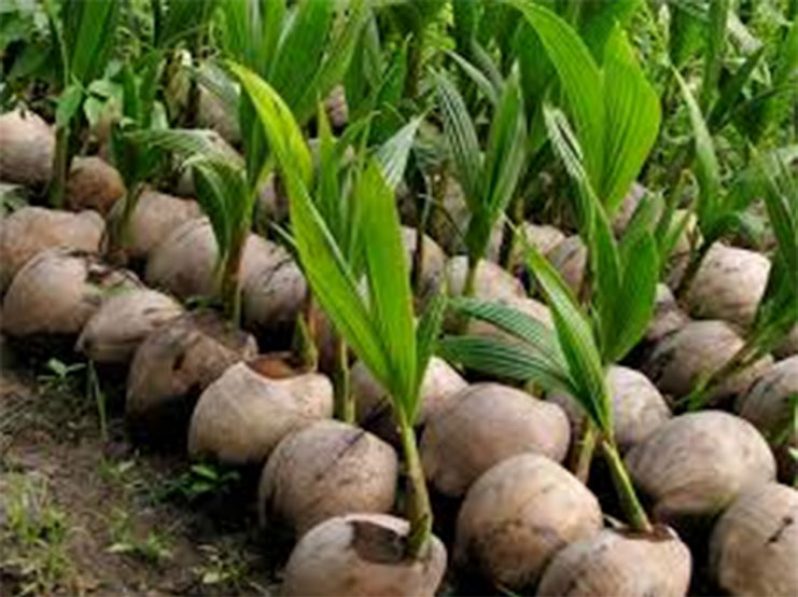— one tree with on-ending possibilities

By M.Margaret Burke
THE COCONUT TREE can be considered as one of the friendliest trees. It is a display of simplicity, yet sophistication. It can be termed magnificent. This tree comes in varying forms: some are tall, some medium height, while there is the short and very short looking ones.
Though they are in differing forms, they all speak of beauty and poise, of usefulness, power, and an assortment of reproductive undertakings.
The coconut tree shoots directed out of its seed, which is a combination of a casing of husk, hard shell, nut and water – all of which are useful in a variety of ways, once used up and not allowed to turn into the seedling, which results in the superb plant i.e. the coconut tree.
Coconut Festival Conference
In October 21 – 23, 2016 the First Coconut Festival Conference was held at the Arthur Chung Convention Center. It was as a result of a collaborative effort between the Ministry of Business – Department of Tourism – and the Ministry of Agriculture and received support from the International Trade Centre (ITC) and the Caribbean Agricultural Research and Development Institute (CARDI).
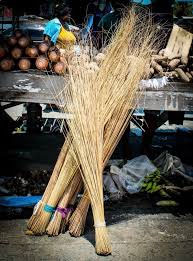
at a farmer’s stall
This was a very significant conference on the coconut industry, with special reference to Guyana, as well as other Caribbean countries. Special efforts were aimed at re-educating Guyanese about the diverse benefits of the coconut fruit focusing on its economic diversification and multi-purpose use while heightening awareness and boosting the local agro-tourism sector.”
Too much (in every respect) was put into this conference to let the dream now die or go into a deep slumber – to hibernate for too long.
Potentials
The coconut industry in Guyana has reachable potentials, which can and must be achieved. But somehow people tend to procrastinate on ideas, which others, even within the Caribbean would take up and run with, almost seamlessly.
On the team of experts, who so knowledgeably released studied information on the various topics were high-level members of the University of Guyana – Faculties of Agriculture and Forestry, NAREI, IAST, FAO, IICA, CARDI and other NGO’s, and the Private Sector.
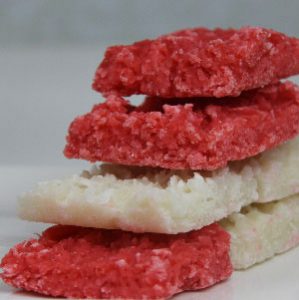
There were also discussions on matters of Coconut Research at the level of the University of Guyana, the use of activated carbon from coconut shell, value added to coconut, oil, copra and waste.
Additionally, there were healthy discussions on the challenges and experiences of the coconut industry in Guyana; the influence of coconut consumption, as well as health risks and benefits.
Coconut and tourism linkages were yet other well-discussed topics posited at the conference. In fact, it linked coconut tourism as a fine product – “from tree to table…to gift shop and tours.”
These men and women took the time to put together very meaningful presentations, which were well received and encouraged interesting discussions, suggestions and recommendations.

On-ending uses
One farmer in a village on the East Coast described the coconut tree as: “A sweet thing.” He declared that whenever farmers go down to the back lands to farm they sometimes end up spending an entire day and the coconut tree then becomes one of their main source, both for use and preparation of the meals, as well as the fire to cook it. “The first thing is that all awee food does have coconut inside. We would pick up dried coconut from the ground and after grating them, we would use a part of the tree that is inside by the branch to strain the milk. Then we would use the coconut shell to make fire to cook de pat – the shell does wuk good and make strong fire,” he said.
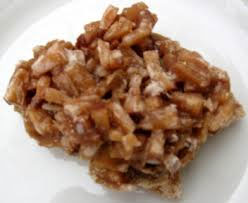
Another female farmer, Pammie from Victoria village on the East Coast said that her best part of the coconut tree is the branches. She stated that she built her home with the use of the branches, which she has been stripping to make ‘pointer brooms’ for sale. “I would strip plenty broom and pack them away and then when I feel that I have enough to last, say a week, two weeks, then I would come down to town and sell. Deh gat some nice places, when you go through them you can make a lot of money in a day. My price would go up and down, depending on who I am selling and in which part of town.” Pammie said that at first it used to be hard work, “My fingers used to be sore and sometimes a bit cut-up, but now I understand the wuk good and I do not find it so hard now.”
Another coconut farmer, who smilingly said to call her ‘Sugar Cake Lady’ told of making lovely coconut sugar cakes. “I make ‘chip-chip sugar cakes; then I grate some with the large side of the grater and some with the small side. Some people like them grate fine, while some people like them from the coarse side. I also make ‘white’ sugar-cake. I cut out the back and then grate them and then I use white sugar. I make all kinds, different, different colours.”
‘Sugar Cake Lady’ went on to say that she loves to be very creative and so she would change the white sugar cake to other colours. “I would also add my own ‘secret ingredients’ to make then taste lovely – ‘morish’,” she laughed. She said that she get orders, even from people overseas, who after buying when they come to Guyana, share with their friends and family, who make contact with her to get some of their own. “It is not really big, big money business, but enough for me to get by and mind meh children, pay meh bills and other things and still get something lef back.”
There are also many more uses for the coconut, which include the coconut plus cassava quinches, which is a mixture from the cassava bread, but sandwiched with sweetened and coloured grated coconut; coconut biscuits (now in many forms), coconut cassava pone, and many more. Added to these are some other products on the market such as the (now) ‘precious’ coconut oils, hair dressings, shampoos, body creams and the like.
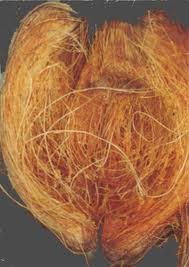
Some raw products
In continuing to look at its on-ending uses, the coconut tree, when used wisely can produce from clothing to homes.
The coconut husk is used to make mattresses, ropes, mats, baskets, ornaments and other products.
On a lighter note, the coconut bat, taken from the head of the branch makes for a lovely game of cricket. Here, the wicket is made from the coconut bat; at times it is used for the bat. So you can relax with a cool glass of coconut water and play some good cricket. mercilinburke2017@gmail.com



.jpg)





